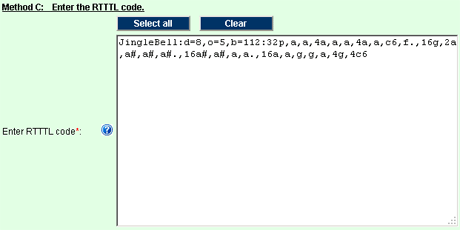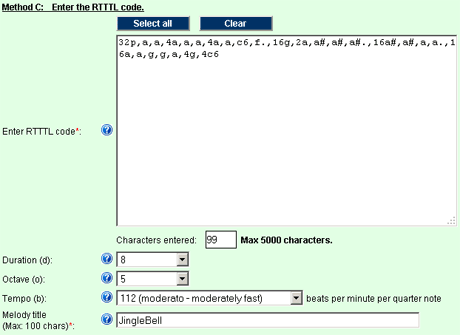RTTTL is used to create ringtones which can be uploaded onto mobile phones but Mobilefish.com uses this format to create MIDI files.
An RTTTL code looks like:
JingleBell:d=8,o=5,b=112:32p,a,a,4a,a,a,4a,a,c6,f.,16g,2a,a#,a#,a#.,
16a#,a#,a,a.,16a,a,g,g,a,4g,4c6
The RTTTL code is divided into three sections that are separated by colons ":".
<name section>:<default value section>:<data section>
- The <name section> contains the Melody title.
For example: JingleBell - The <default value section> contains the duration (d), octave (o) and tempo (b) values.
For example: d=8,o=5,b=112 - The <data section> contains the actual melody.
For example: 32p,a,a,4a,...,a,4g,4c6
- Method 1:
Enter the RTTTL code in its original form in the "Enter RTTTL code" inputbox:
<name section>:<default value section>:<data section>
For example:

Do not use the Duration pulldown, Octave pulldown, Tempo pulldown and Melody title input field. These values will be changed automatically later.
- Method 2:
Only enter the <data section> values in the "Enter RTTTL code" inputbox and change the Duration, Octave and Tempo pulldown menus and enter a title in the Melody title input field.
For example:

- The name section (JingleBell)
A string containing the melody title.
Maximum 100 printable ISO-8859-1 characters are allowed.
For example: JingleBell
- The default value section (d=8,o=5,b=112)
Three key-value pairs separated by commas, which describes the melody defaults.
If any of these three values is missing from the default value section, the following defaults are assumed: d=4,o=4,b=112.
- d - Duration (Allowed values: 1, 2, 4, 8, 16, 32, 64, 128)
For example: d=8
Duration is how long a note is played compared to a whole note.
- 1 - whole note (1)

- 2 - half note (1/2)

- 4 - quarter note (1/4)

- 8 - eighth note (1/8)

- 16 - sixteenth note (1/16)

- 32 - thirty-second note (1/32)

- 64 - sixty-fourth note (1/64)

- 128 - hundred-twenty eighth note (1/128)

- 1 - whole note (1)
- o - Octave (Allowed values: 0, 1, 2, 3, 4, 5, 6, 7, 8)
For example: o=5
This tool uses 9 octaves (octave 0 - octave 8).
Note:
Octave 0 and 8 are not displayed in the image below but are used by this tool.
Click this image to zoom in.

- b - Beats per minute (Allowed values: 25, 28, 31, 35, 40, 45, 50, 56, 63, 70, 80, 90, 100, 112, 125, 140, 160, 180, 200, 225, 250, 285, 320, 355, 400, 450, 500, 565, 635, 715, 800, 900)
For example: b=112
If a melody is assigned a "112 beats per minute" value, this means that the melody will get one beat each (60/112 = ) 1.867 second. If you want the melody to go twice as fast, you increase the beat to 224.
- d - Duration (Allowed values: 1, 2, 4, 8, 16, 32, 64, 128)
- The data section (32p,a,a,4a,...,a,4g,4c6)
The data section holds tha actual melody and is a set of string pairs separated by commas, where each string pair contains:
a duration-pitch-octave and optional dotting (which increases the duration of the note by one half).
For example:
32p,8g.,16e,c,e,g,2c6,8e6,16d6,c6,e,f#,2g,g,e6,8d6,c6,2b,8a.,16b,c6,c6,g,e,c
- Duration (Allowed values are: 1, 2, 4, 8, 16, 32, 64, 128)
See also explanation above.
Instead of playing notes you can also not play anything for a specific duration, the so called pause (p). How long a pause should last is indicated by:
- 1 - whole rest (1)

- 2 - half rest (1/2)

- 4 - quarter rest (1/4)

- 8 - eighth rest (1/8)

- 16 - sixteenth rest (1/16)

- 32 - thirty-second rest (1/32)

- 64 - sixty-fourth rest(1/64)

- 128 - hundred-twenty eighth rest (1/128)

For example:
The default value section: d=4,o=5,b=112
RTTTL code: d6,8c#6.,16b,a.,8g
The RTTTL code looks like: 4d6,8c#6.,16b,4a.,8g
- 1 - whole rest (1)
- Pitch (Allowed values are: a, a#, b, h, c, c#, d, d#, e, f, f#, g, g#, p)
The pitch indicates how high or low a note should be played.
If the pitch of a note is higher than another, it will be written higher up on the staff.
If the pitch of a note is lower than another, it will be written lower down on the staff.
The following pitch values (lower or upper case) are allowed:
Pitch Represents note a A a# A# or Bb b or h B or Cb
In most countries the C major scale is written as: C,D,E,F,G,A,B,C. In Northern European countries (such as Estonia and Denmark) the C major scale is written as: C,D,E,F,G,A,H,C.c C c# C# or Db d D d# D# or Eb e E or Fb f F or E# f# F# or Gb g G g# G# or Ab p Rest or pause (no sound)
- Octave (Allowed values are: 0, 1, 2, 3, 4, 5, 6, 7, 8)
See explanation above.
For example:
The default value section: d=4,o=5,b=112
RTTTL code: d6,8c#6.,16b,a.,8g
The RTTTL code looks like: d6,8c#6.,16b5,a5.,8g5
Note:
RTTTL codes for mobile ringtones only uses 4 four octaves (4,5,6,7).
Octave 4 - Note A is 440Hz
Octave 5 - Note A is 880Hz
Octave 6 - Note A is 1760 Hz
Octave 7 - Note A is 3520 kHz
Mobilefish.com however uses 9 octaves to create MIDI files.
- Optional dotting (Allowed value: .)
A dotted character (.) can be specified AFTER the duration-pitch-octave pair.
A dotted duration is one in which a note is given the duration of "itself + half of itself."
For example:
A dotted quarter note C, octave 6 (4c6.) has a value of a quarter note plus an eighth note.
A dotted eighth note F#, octave 5 (8f#5.), has a duration value of an eighth note plus a sixteenth note.
- If no duration or octave specifier are present, the default applies.
- The character p indicates a rest (pause). Because rests don't occur in an octave, you don't use an octave indicator.
[duration]-pitch-[octave][dotting] pair Explanation 8f#5 1/8 note F#, octave 5 8d5 1/8 note D, octave 5 8p 1/8 pause 4p 1/4 pause 4p. 1/4 + 1/8 pause p 1/4 pause c5 1/4 note C, octave 5 8d 1/8 note D, octave 6 2e. 1/2 + 1/4 note E, octave 6 4c5. 1/4 + 1/8 note C, octave 5 8d#6. 1/8 + 1/16 note D#, octave 6 c# 1/4 note C#, octave 6 d 1/4 note D, octave 6 - Duration (Allowed values are: 1, 2, 4, 8, 16, 32, 64, 128)